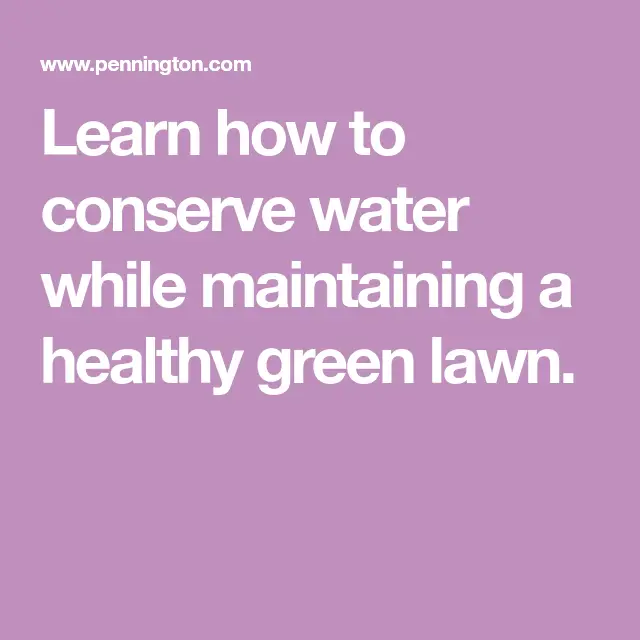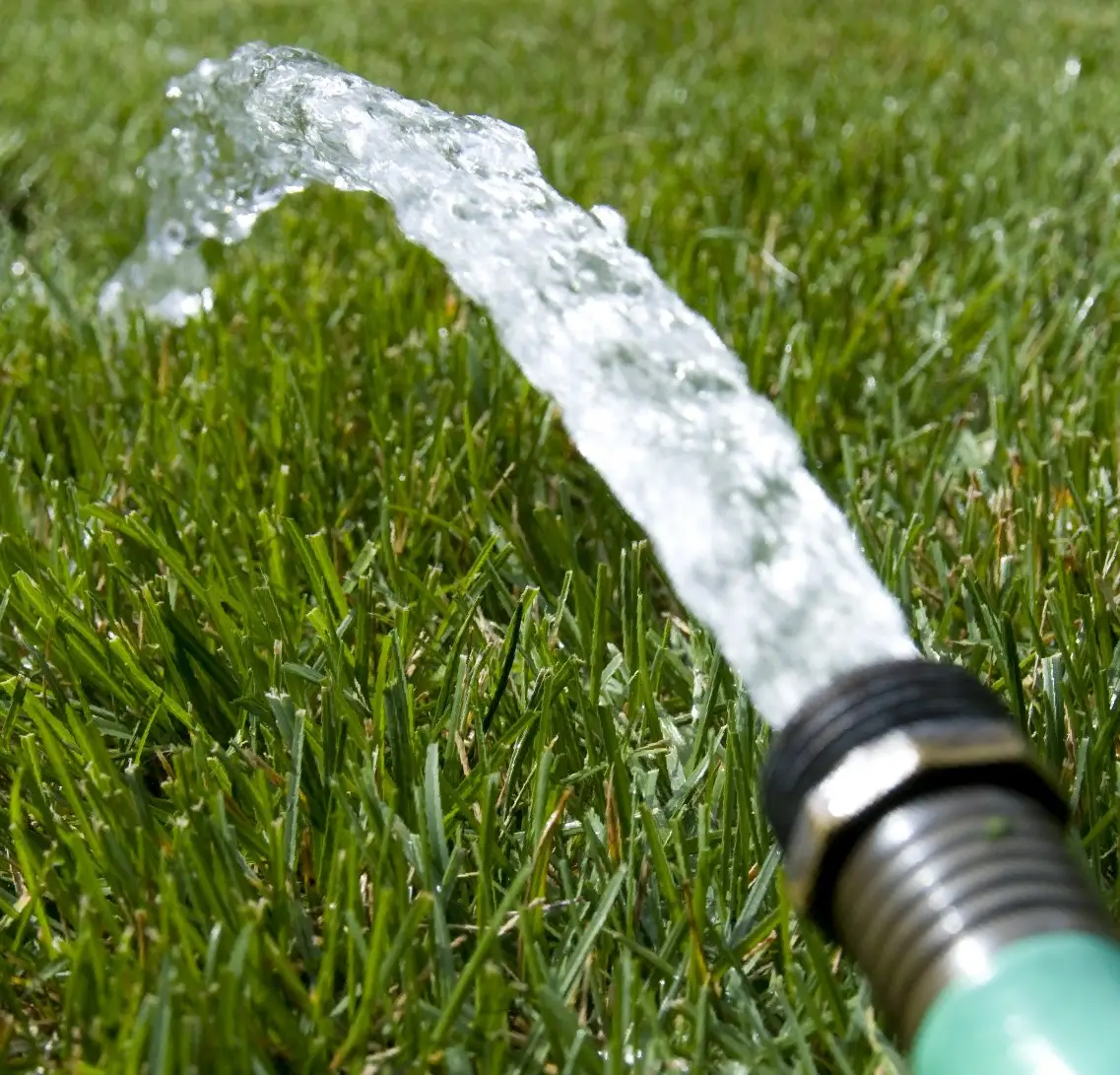Reuse Grey Water For Watering Plants And Grass
The idea of using Grey Water might actually cause you to cringe a bitbut dont worry. Were definitely NOT talking about using sewage to water your plants.
Sewage water is considered Black Water, and is not safe for reuse. In this case, we are talking about water with very little bacteria and contaminants that usually comes from bathtubs and sinks. This method of water conservation depends largely upon what is allowed in your area and what code restrictions are in place for gray waterand how far you are willing to go.
Some people take things to the extreme when collecting grey water, such as removing the pipe fittings from beneath their sink and placing buckets underneath to catch water. Other homeowners have installed valves in their tubs which allow grey water to be captured and stored in outdoor containers.
This method is not practical for everyone, but may be a worthy investment for people with larger lawns.
Recycle Water When Possible
Recycling water for irrigation requires proper design of water storage and separation to supply the water to irrigation sprinklers. Professional contractors who have expertise in this area have designed these systems for large commercial buildings and sports complexes. You can buy rain barrels from local municipalities and companies to reuse rainwater to irrigate your landscape plants.
Top Tips For A Healthy Lawn
A green and healthy lawn is easy to achieve with a bit of work. A little effort now will save you a lot of effort later, because healthy lawns are less vulnerable to pests, weeds, drought, and other problems.
Follow these seven tips:
Recommended Reading: How To Get More Clients For Lawn Care
Also Check: What Type Of Fertilizer Do I Need For My Lawn
Seed Your Lawn In Fall
Depending on the location of your home, Autumn is typically the season when the soil temperature reaches 55. Since turf roots grow extensively in the fall and winter, this is the prime time for seeding your lawn. While it may be tempting to go for the inexpensive seed, it can hurt you in the long run.
Cheap seed often contains weed seed, annual rye grass seed and hollow husks, which will typically drop dead after the first frost. If you want a lush lawn come spring, it is best to spend a couple bucks more and upgrade to the expensive seed, which is more likely to be better at resisting insects, disease and drought.
After you plant the seed, water it every day until it germinates. Typically, this takes approximately 10 to 20 days.
Read Also: Which Lawn Weed Killer Is The Best
A Dog Urine Lawn Neutralizer Can Help Recondition The Soil

If you cant designate a potty area, then youll want to look into dog urine grass saver, dog urine lawn neutralizer and other products, like Scotts EZ Seed Dog Spot Repair, that are specifically formulated to treat damaged lawns. Products like these are designed to neutralize salt, nitrogen and other chemicals and may also include other ingredients to promote the growth of healthy grass.
Rather than using a dog urine grass saver on their lawn, some people choose to address the problem at its source by feeding their dog supplements designed to lower the pH level of urine. However, these supplements can have serious health complications so Im not comfortable recommending them. A safer alternative are products, like Dog Rocks, that can be added to the dogs water to filter out impurities that can negatively affect grass without any dangerous side effects for your dog.
Theres no reason why your dogs bathroom needs should prevent you from enjoying your lawn. With some simple, safe and chemically sound options like dog urine grass saver, you can continue to have the lush, green lawn you want with no more ugly yellow stains.
Save This Pin!
Don’t Miss: What’s The Fastest Riding Lawn Mower
Make Use Of Greywater In The Garden
Any water that has been used in the home, except water from toilets, is called ‘greywater’. Shower, sink and laundry water can be re-used in the garden during droughts. Greywater from baths and showers can be used to water non-edible plants – make sure it is cool before you use it and don’t pour it straight onto foliage.
Benefits Of Conserving Water In Your Lawn Or Garden
On average, nearly half of a home’s water usage goes toward keeping the yard looking nice and well-maintained. Water saving is especially important in times of drought, but even when theres plenty of rain, there are several benefits of conserving water in your lawn or garden:
- Water efficiency helps divert less water away from our bays and rivers, keeping our waterways healthy.
- Less water usage equates to lower energy demand, which helps reduce air pollution.
- Using less water to maintain your yard can lower wastewater treatment costs.
- The more you conserve water in your lawn or garden, the more youll save on your monthly water bill.
Read Also: How Much To Get Lawn Mowed
From Skipping The Fertilizer To Sharpening Your Mower Blades Here’s How To Help Your Lawn Survive When Water Is Scarce
Almost overnight, it seemed the moist green ground of spring turned into the brown-hardened throes of late summer. Thats especially true for those of us in the Western U.S., where drought has firmly sunk in its claws. Keeping a lawn green out here is not only difficult, it might not even be an option in coming years.
Increasingly, some homeowners are replacing bluegrass and fescue with native grasses and plants, which can survive with little to no supplemental water. But for those who arent ready to part with their lawns just yet, its still possible to mostly keep that welcoming patch of grass around through the hottest months.
You dont always have ideal conditions for keeping your lawn looking its best during a drought, but there are a few things you can do to help it keep thriving, says Bill Freimuth, president of Centurion brands garden and outdoor products.
Maintaining your yard prior to drought with the correct level of fertilizer, coupled with good water management practices, will help reduce damage.
If youre in a drought area or under water restrictions, here are some tips to try to preserve your lawn so you can bring it back to normal once the heat drops and the rains return.
On This Page
Save Water When Watering Your Lawn And Landscape By Upgrading Your Sprinkler System
Finally, we would be remiss in not mentioning that if you are operating an older irrigation system, you are very likely wasting unnecessary water. Today, smart irrigation technology is available that offers much more efficient watering.Smart irrigation systems are those that tailor their watering schedules and run times to the actual conditions, not just blindly following a preset schedule. A smart irrigation controller that makes these types of adjustments will significantly improve water efficiency.
Weve seen tremendous advances in smart irrigation in the last 5 years. The capabilities have come so far. With technology such as rain and freeze sensors, as well as soil moisture sensors, the system can make real-time changes. Many systems also utilize data coming from the local weather station in terms of previous and upcoming conditions.This all adds up to better watering. Instead of having your irrigation system kick on during a rainstorm , your system will adjust automatically. We have even found that some municipalities that have water restrictions will allow those restrictions to be overridden if you have a smart controller that youve registered with their county. Thats because they know smart controllers are helping with water conservation by putting out exactly what your property needs .
You May Like: How To Treat Red Thread In My Lawn
Lay Down New Turf In Spring Or Fall
TifTuf can be installed at any time, but the best time for water efficiency is spring or fall when the weather is temperate and water doesnt evaporate too quickly. Freshly installed turf needs more water than a mature lawn. So laying down turf in the summer means lots of water lost to evaporation. Make use of the cooler seasons to install your TifTuf Bermudagrass and save water on your lawn. Youll be happy you did it.
How Many Minutes A Day Should You Water Your Lawn
Watering your lawn is not a matter of time but rather of moisture levels in the soil. Only when it is dry 6 inches below the grass is watering required. Once you begin, water in small increments until the soil is moist, then stop.
Instead of watering for a predetermined number of minutes and disregarding the moisture content of the soil, this is a better way to nourish your lawn and avoid wasted water.
Recommended Reading: What To Pay For Lawn Mowing
Avoid Overwatering With An Irrigation System
When it comes to ways that you can save water when watering plants or the lawn, it seems obvious that you want to avoid overwatering. However, we find that homeowners often dont have a good grasp on how much theyre supposed to apply.
At Grassperson, we closely follow the recommendations put out by Texas A& M AgriLife Extension, which are based on scienceand a lot of research. For watering lawns, their recommendation is a minimum of one inch of water per week . The same typically goes for landscape plants. Most plants need around one inch of water per week, though they may require more during periods of drought. There can also be some variation depending on the type of plant material you have in your landscape. A landscape professional can help you get a good sense of how much to water.
Of course, getting out there with a hose or sprinkler that you have to drag around is far from optimal. Its a lot easier to achieve just the right amount of watering when using an irrigation system. In fact, here in North Texas, where drought conditions are likely, its hard for lawns and landscapes to survive without irrigation. You can ensure that the system is set to water the proper amount.Thats not to say that there will never be a problem. Overwatering a lawn or landscape usually happens as the result of a faulty irrigation system, a point that well discuss next.
Pay Attention To The Weather

During a Minnesota summer, we may see heavy periods of rainfall followed by extended drought. Homeowners with lawns should adjust irrigation practices accordingly. This means no longer relying on the set it and forget it irrigation schedule that is often programmed into automatic systems.
Operating irrigation controllers in manual mode is one way to solve this issue: turn the controller on only when your lawn shows signs of drought.
Don’t Miss: How To Start Lawn Cutting Business
Mow Grass To The Correct Height
One way to save water is to mow your grass to the correct height. Mowing guidelines vary depending upon your region and type of grass.
Typically, a slightly higher mow will allow a deeper root system to develop. The deeper roots can reach down for water within the soil, the less watering is required. If you mow too short, the grass will need more water to sustain itself and will brown more easily during drought periods.
We know that no one wants to be that guy with the unkempt yard, but arming yourself with knowledge can help you strike the right balance between beauty and efficiency.
Adjust Irrigation Programs To Conserve Water
To encourage rooting and drought tolerance, you should irrigate your lawn infrequently with a sufficient volume of water to wet soils to a depth of six inches, assuming no rainfall has occurred. Depending on your soil type, your lawn may only need as little as a half-inch of water.
Set irrigation programs to water during the morning hours. Watering during the heat of the day reduces the amount of water absorbed by the soil and made available to plants.
Also Check: Does Big Lots Carry Lawn Mowers
Use A Rain Gauge Or Soil Moisture Meter To Determine When Your Lawn Actually Needs Water
Overwatering your lawn can not only waste water, but it can also damage your lawn by promoting disease and encouraging weed growth. By using a rain gauge or soil moisture meter, you can make sure that youre only watering your lawn when it truly needs it.
To use a rain gauge, simply place it in an open area of your lawn and check it after it rains. If the rain gauge has more than 1 inch of water in it, then your lawn doesnt need any additional water.
A soil moisture meter is a bit more complex, but can be well worth the investment if you want to make sure youre watering your lawn correctly. To use a soil moisture meter, insert it into the ground at several different spots around your lawn. The meter will give you a reading of how much moisture is in the soil.
If the readings are all above 50%, then your lawn doesnt need any additional water. If the readings are below 50%, then you may need to water your lawn.
Creating A Brighter Future
As youve hopefully learned above, there are many ways to reduce water use during lawn maintenance. Choosing to preserve water is one of the best things you can do to help create a sustainable future not only for us, but for future generations. Visit Spring Power & Gas to learn about more ways that you can contribute to a brighter future for our planet.
Recommended Reading: Where To Buy Replacement Webbing For Lawn Chairs
Replace Some Grass Areas
Ornamental grasses and low water use plants arent just easier to maintain than turf and require less water, but theyre also aesthetically pleasing. Ground moss plants serve as a better alternative ground cover as they are low growing and derive the essential nutrients and moisture needed for growth from the air. If these dont sound appealing to you, there are other options such as artificial turf, or even yards with rock landscaping that require no water at all.
How To Conserve Water In Your Lawn
Our society is increasingly concerned about water. Water is a finite natural resource that is essential to our world, and it is also vital to the lawns we enjoy with our friends and families.
People are seeking ways to keep their lawns thick and green while respecting the environment and conserving water especially during periods of drought. Can a lawn be smart in how it uses water? Can it use it more efficiently? Can it live with less?
The answer is “yes.” Like any plant, grass needs nutrients to thrive. Therefore, a smart water conservation plan for any lawn starts with feeding. Feeding not only improves a lawn’s appearance, it also strengthens and thickens the grass to help the lawn protect itself against drought. A well-fed lawn grows deeper roots to better absorb water and nutrients. Compared to an unfed lawn, a lawn that is fed uses water more efficiently. Here are four easy tips to follow to help your grass conserve water:
Leave the grass clippings on your lawn. When mowing, leave the clippings on the lawn. Grass clippings break down quickly and return beneficial nutrients to the soil. Mow often enough to ensure too much of the grass blade isn’t removed at once. Removing too much of the grass blade shocks the grass and leaves clipping piles on the lawn that can smother grass.
*check your local laws and regulations including product directions for use for application rates and frequencies.
Don’t Miss: What Is The Best Lawn Chair
Use Mulch And Rocks To Naturally Absorb Water
Mulch and rocks are a simple way to conserve water when they are installed around ornamental plants, bushes, shrubs, and trees.
When they are installed to the correct depth, mulch and rocks can prevent the sun from drying up the soil beneath your plants. Your irrigation system will require less water and the soil will soak up rainwater more efficiently. One big plus is that mulch and rocks look great if they are refreshed once a year.
Water During The Right Time Of The Day

A lot of communities have established water restrictions that limit sprinklers from running during certain times of the day. These limitations are imposed to reduce water waste in your area and should, therefore, be followed. But as a general guideline, you should avoid watering your grass during the hottest part of the day due to the higher evaporation loss that occurs from the sun. Instead, water your lawn early in the morning or later in the evening when temperatures are cooler and the risk of evaporation is lower.
Don’t Miss: How To Make My Lawn Dark Green